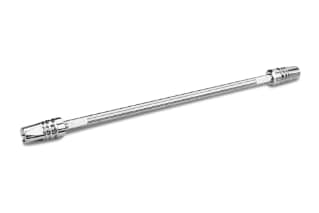
|
Chemistry |
C18 |
|
Separation Mode |
Reversed Phase |
|
Particle Substrate |
Silica |
|
pH Range Min |
2 pH |
|
pH Range Max |
8 pH |
|
Temperature Limits |
45 C |
|
Maximum Pressure |
18000 psi (1240 Bar) |
|
Endcapped |
Yes |
|
Bonding Technology |
T3 |
|
Silanol Activity |
Medium |
|
Particle Shape |
Spherical |
|
Particle Size |
1.8 µm |
|
Endfitting Type |
Parker-style |
|
Pore Size |
100 Å |
|
Format |
Column |
|
Surface Area |
230 |
|
System |
UPLC, UHPLC |
|
Particle Technology |
HSS |
|
USP Classification |
L1 |
|
Inner Diameter |
1 mm |
|
Length |
150 mm |
|
Carbon Load |
11 % |
|
eCord |
Yes |
|
UNSPSC |
41115709 |
|
Brand |
ACQUITY UPLC |
|
Product Type |
Columns |
|
Units per Package |
1 pk |

ACQUITY UPLC HSS T3 Column, 100Å, 1.8 µm, 1 mm X 150 mm, 1/pk
The universal, silica-based bonded phase utilized for the ACQUITY HSS T3 sorbents is compatible with 100% aqueous mobile phase and should be your first choice for producing separations for polar and non-polar substances. ACQUITY HSS T3 UPLC columns have extremely little MS bleed and are fully scalable and transferrable to HPLC separations.
To effectively negotiate the challenges of liquid chromatography, add the ACQUITY UPLC HSS T3 Column to your arsenal of lab materials. Reversed-phase liquid chromatography is the ideal application for the lab equipment's low ligand density for increased retention of polar molecules and metabolites. Using the ACQUITY UPLC HSS T3 Column will allow the analytes to enter the pore structure of the material. As a result, ion-pair reagents are no longer required for polar and hydrophobic molecule retention.
Use the ACQUITY UPLC HSS T3 Column's great value to meet a wide range of chromatographic needs. The lab equipment makes it straightforward to switch approaches while increasing productivity and maintaining or improving resolution across components. Recognizing that the wide range of analyte polarity can make developing chromatographic procedures difficult, Waters developed the ACQUITY UPLC HSS T3 Column to enable the use of a single chromatographic methodology to study a variety of formulation compositions. Because of the incredible properties of the ACQUITY UPLC HSS T3 Column, you will not only be able to meet the challenges of the laboratory, but you will also be more productive and successful in your work.
The Waters HSS (High Strength Silica) particle technology utilized in the ACQUITY UPLC HSS T3 Column was specially developed to endure UPLC pressures by combining a silica-based material that is mechanically tolerant with an innovative synthetic technique that considerably enhances silica's mechanical stability. When compared to hybrid particle technology, this has higher retentivity and alternative selectivity.
You can shop for lab equipment on our website and contact us if you have any questions or need help picking the best products for your lab. You may also be interested in looking at Neutrals QC Reference Material; this material can be used in any chromatographic system that has a UV detector. It is intended to act as a system benchmarking standard, and it can be utilized with a variety of separation approaches. The mixture contains only neutral chemicals. When used regularly and with control charts, the QC Reference Material will offer you confidence in your results, reduce troubleshooting and rerun time, and allow you to compare results from multiple laboratories.
How Are Pesticides Tested?
Pesticide residue testing involves conducting a comprehensive chemical and microbiological analysis to determine the levels of pesticide residues present in food items. This meticulous examination instills confidence in the food makers and producers regarding the composition of their products.